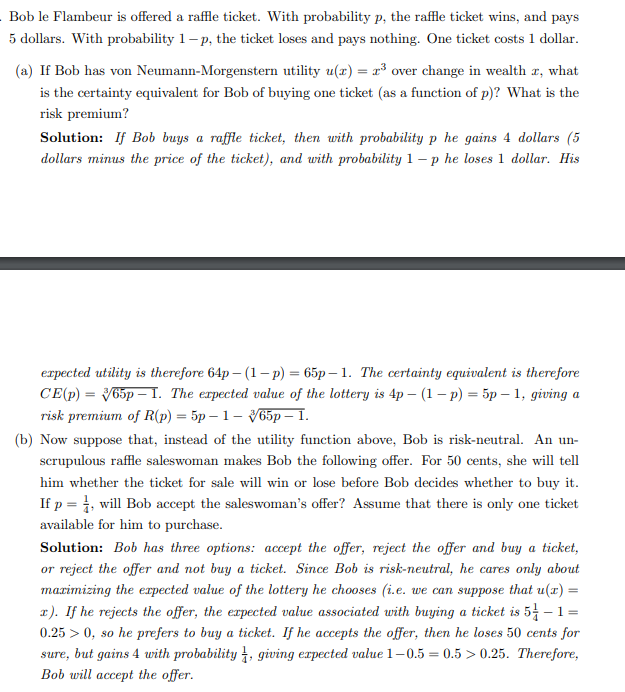5 dollars. With probability 1-p, the ticket loses and pays nothing. One ticket costs 1 dollar. (a) If Bob has von Neumann-Morgenstern utility u(x) = 2³ over change in wealth z, what is the certainty equivalent for Bob of buying one ticket (as a function of p)? What is the risk premium? Solution: If Bob buys a raffle ticket, then with probability p he gains 4 dollars (5 dollars minus the price of the ticket), and with probability 1-p he loses 1 dollar. His
5 dollars. With probability 1-p, the ticket loses and pays nothing. One ticket costs 1 dollar. (a) If Bob has von Neumann-Morgenstern utility u(x) = 2³ over change in wealth z, what is the certainty equivalent for Bob of buying one ticket (as a function of p)? What is the risk premium? Solution: If Bob buys a raffle ticket, then with probability p he gains 4 dollars (5 dollars minus the price of the ticket), and with probability 1-p he loses 1 dollar. His
Chapter7: Uncertainty
Section: Chapter Questions
Problem 7.3P
Related questions
Question
please only do: if you can teach explain steps of how to solve each part b

Transcribed Image Text:Bob le Flambeur is offered a raffle ticket. With probability p, the raffle ticket wins, and pays
5 dollars. With probability 1-p, the ticket loses and pays nothing. One ticket costs 1 dollar.
(a) If Bob has von Neumann-Morgenstern utility u(r) = ³ over change in wealth , what
is the certainty equivalent for Bob of buying one ticket (as a function of p)? What is the
risk premium?
Solution: If Bob buys a raffle ticket, then with probability p he gains 4 dollars (5
dollars minus the price of the ticket), and with probability 1-p he loses 1 dollar. His
expected utility is therefore 64p-(1-p) = 65p-1. The certainty equivalent is therefore
CE(p) = 365p 1. The expected value of the lottery is 4p - (1 - p) = 5p - 1, giving a
risk premium of R(p) = 5p-1-65p - 1.
(b) Now suppose that, instead of the utility function above, Bob is risk-neutral. An un-
scrupulous raffle saleswoman makes Bob the following offer. For 50 cents, she will tell
him whether the ticket for sale will win or lose before Bob decides whether to buy it.
If p = 1, will Bob accept the saleswoman's offer? Assume that there is only one ticket
available for him to purchase.
Solution: Bob has three options: accept the offer, reject the offer and buy a ticket,
or reject the offer and not buy a ticket. Since Bob is risk-neutral, he cares only about
maximizing the expected value of the lottery he chooses (i.e. we can suppose that u(x) =
r). If he rejects the offer, the expected value associated with buying a ticket is 5-1=
0.25 > 0, so he prefers to buy a ticket. If he accepts the offer, then he loses 50 cents for
sure, but gains 4 with probability, giving expected value 1-0.5 = 0.5> 0.25. Therefore,
Bob will accept the offer.
Expert Solution
This question has been solved!
Explore an expertly crafted, step-by-step solution for a thorough understanding of key concepts.
Step by step
Solved in 3 steps with 3 images

Knowledge Booster
Learn more about
Need a deep-dive on the concept behind this application? Look no further. Learn more about this topic, economics and related others by exploring similar questions and additional content below.Recommended textbooks for you

